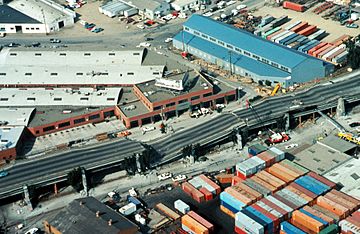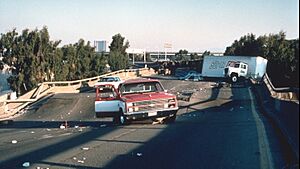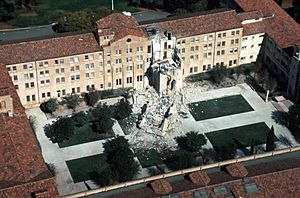1989 Loma Prieta earthquake facts for kids

Image of collapsed Cypress freeway structure in Oakland, California
|
|
| UTC time | 1989-10-18 00:04:14 |
|---|---|
| ISC event | 389808 |
| USGS-ANSS | ComCat |
| Local date | October 17, 1989 |
| Local time | 17:04:15 PDT |
| Duration | 8–15 seconds |
| Magnitude | 6.9 Mw, 7.2 Ms |
| Depth | 19 km (12 mi) |
| Epicenter | 37°02′N 121°53′W / 37.04°N 121.88°W |
| Type | Oblique-slip reverse |
| Areas affected | Central Coast (California) San Francisco Bay Area United States |
| Total damage | $5.6–6 billion (equivalent to $13.2–14.2 billion today) |
| Max. intensity | IX (Violent) |
| Peak acceleration | 0.65 g (at epicenter) |
| Tsunami | Yes |
| Landslides | 1,000–4,000 |
| Foreshocks | 5.3 ML June 27, 1988 5.4 ML August 8, 1989 |
| Casualties | 63 killed, 3,757 injured |
The 1989 Loma Prieta earthquake shook California's Central Coast on October 17, 1989. It happened at 5:04 p.m. local time. The earthquake's center was in The Forest of Nisene Marks State Park in Santa Cruz County. This spot is about 10 miles (16 km) northeast of Santa Cruz. The quake was named after Loma Prieta Peak nearby in the Santa Cruz Mountains.
This earthquake had a magnitude of 6.9. Its highest Modified Mercalli intensity was IX, which means it was "Violent." The quake caused 63 deaths and injured 3,757 people. The area of the San Andreas Fault where this quake happened had been quiet since the 1906 San Francisco earthquake. Scientists call such a quiet area a "seismic gap." Two smaller earthquakes, called foreshocks, happened in this area in 1988 and 1989 before the main quake.
Damage was severe in Santa Cruz County. It was less bad in Monterey County to the south. But the effects reached far north into the San Francisco Bay Area. This included the San Francisco Peninsula and Oakland. The ground did not break open at the surface. However, many landslides and other ground failures happened. This was especially true in the Summit area of the Santa Cruz Mountains.
Liquefaction was also a big problem. This is when soil acts like a liquid during shaking. It caused much damage in the Marina District of San Francisco. It also affected areas in the East Bay and near Monterey Bay. A small, harmless tsunami was also seen there.
The earthquake happened during a live TV broadcast of the 1989 World Series. This is a big baseball championship. The teams playing were the San Francisco Giants and the Oakland Athletics, both from the Bay Area. Because of this, the quake is sometimes called the "World Series earthquake." Traffic on Bay Area freeways was lighter than usual. Many people were already at home or at parties to watch the game. This likely saved many lives. Several major bridges and roads collapsed. The collapse of a part of the Nimitz Freeway in Oakland caused the most deaths. Other collapses and accidents also led to deaths in San Francisco, Los Altos, and Santa Cruz.
Contents
What Caused the Loma Prieta Earthquake?
The Loma Prieta earthquake got its name from Loma Prieta Peak. This peak is in the Santa Cruz Mountains, east of where the earthquake started. The strongest shaking in the Santa Cruz Mountains lasted about 15 seconds. In areas with solid rock, the shaking was shorter and less intense.
How Did the Ground React?
Most landslides happened southwest of the earthquake's center. They occurred along road cuts in the Santa Cruz Mountains. The Summit Road area also saw many slides. Landslides also happened along the Pacific Coast cliffs. Some even reached the Marin Peninsula to the north. Highway 17 was closed for weeks by a large slide. One person died from a rockfall on the coast. Other ground changes included soil moving downhill, slumps, and cracks in the ground.
Who Was Affected by the Quake?
The earthquake directly caused 57 deaths. Six more deaths were indirectly related to the quake. In total, 3,757 people were injured, with 400 of those injuries being serious. The highest number of deaths, 42, happened in Oakland. This was due to the collapse of the Cypress Street Viaduct on the Nimitz Freeway (Interstate 880). The upper level of this double-deck freeway fell onto the lower level. This crushed cars and caused crashes.
A 50-foot (15 m) section of the San Francisco–Oakland Bay Bridge also collapsed. This led to one death, a 23-year-old woman named Anamafi Moala. Three people died when buildings collapsed along the Pacific Garden Mall in Santa Cruz. Five people were killed when a brick wall fell on Bluxome Street in San Francisco.
The third game of the 1989 World Series was about to start when the quake hit. Both teams, the San Francisco Giants and Oakland Athletics, were from the affected area. Many people had left work early or were watching the game with groups. Because of this, the freeways were not as crowded as usual for rush hour. If traffic had been normal, many more people would have been injured or died. Initial news reports thought 300 people had died. This number was later corrected to 63.
What Was the Damage Like?
The earthquake caused major damage in specific areas. These were mainly on unstable soil in San Francisco and Oakland. Oakland City Hall had to be emptied after the quake. It was repaired to be safer from earthquakes. This work cost about $80 million and finished in 1995.
Other effects included sand volcanoes (where sand and water erupt from the ground), landslides, and ground cracks. About 12,000 homes and 2,600 businesses were damaged. The Federal Emergency Management Agency (FEMA) helped people who lost their homes.
In Santa Cruz, near the earthquake's center, 40 buildings fell down. Six people died there.
After the quake, about 1.4 million people lost power. This was mostly because electrical substations were damaged. Many radio and TV stations in San Francisco also went off the air for a while.
The earthquake caused about $6 billion in property damage. At the time, this made it one of the most expensive natural disasters in U.S. history. People and groups donated a lot of money to help. On October 26, President George H. W. Bush signed a $1.1 billion relief package for California.
How Did the Earthquake Appear in Pop Culture?
The Loma Prieta earthquake has been shown in many films and TV shows:
- The TV show Full House had an episode called "Aftershocks." It showed 7-year-old Stephanie Tanner being scared of another aftershock.
- After the Shock (1990) was a TV movie about rescue stories after the disaster.
- Miracle on Interstate 880 (1993) was a TV movie. It showed what happened at the collapsed Cypress Structure.
- Journeyman (2007) was a TV show. The main character traveled back in time to save someone who died in the quake.
- Midnight Caller (1990) was a TV show set in San Francisco after the earthquake.
- The punk band Loma Prieta got their name from the earthquake.
- Medium (2005) was a TV show. A character used the earthquake to fake her death.
- Fringe (2008) was a TV show. A character's parents died in the Bay Bridge collapse.
- The band Grateful Dead played a song called "California Earthquake" after the event. They also played an earthquake benefit concert.
- Gillian Welch sang about it in her song "Wrecking Ball."
- The video game Grand Theft Auto: San Andreas (2004) showed quake-damaged areas in its fictional city of San Fierro.
- A YouTube video from Kane Pixels' Backrooms series linked the quake to a science experiment.
- Episode 6 of Season 1 of Quantum Leap (2022) took place during the earthquake.
Many TV documentaries about earthquakes and disasters have also featured the Loma Prieta earthquake:
- The Quake of 89: The Final Warning? from the BBC show Horizon.
- Nature's Fury by National Geographic.
- Earth's Fury (also known as Anatomy of Disaster).
- Raging Planet on Discovery Channel.
- Mega Disaster on National Geographic Channel.
- Surviving Disaster on the BBC.
- World's Deadliest Earthquakes on ABC.
- Minute by Minute on A&E.
- Critical Rescue on Discovery Channel, focusing on rescuers.
- San Francisco Quake: A Matter of Seconds on TLC.
- Loma Prieta Earthquake, 30 Years Later on NBC station KNTV.
- The Day the Series Stopped from ESPN's 30 for 30 series.
- The graphic novel Smile by Raina Telgemeier shared her experience of the earthquake.
See also
 In Spanish: Terremoto de Loma Prieta para niños
In Spanish: Terremoto de Loma Prieta para niños
- 1906 San Francisco earthquake
- 1994 Northridge earthquake
- Earthquake engineering
- List of earthquakes in California
- List of earthquakes in the United States




